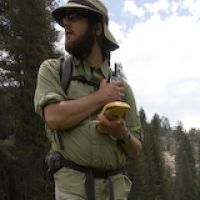Lucas et al., 2010
Polymictic pool behavior in Sierra Nevada Streams.
Lucas, R.G., Conklin, M.H., Tyler, S.W., Suarez, F.I., Moran, J.E., Esser, B.K. (2010)
Fall meeting, American Geophysical Union, December 2010. Abstract H21B-1046.
-
Sierra, GRAD STUDENT
-
Sierra, INVESTIGATOR
Abstract
Pools in streams and meadows in the mid to high Sierra Nevada (1800-2300 m) in low flow scenarios were observed to exhibit polymictic behavior during summer months. Although daily thermal stratification has been observed in pools of various sizes and in multiple locations, the degree and timing of stratification is highly variable and not well understood. Previous studies have shown that thermally stratified stream pools can provide cold water refugia for thermally sensitive species, specifically salmonid fish. Diel temperature patterns demonstrating daily thermal stratification and nightly mixing of small (1-4 m diameter and 1-2 m deep) pools in the Long Meadow complex (Sequoia National Park, CA) were observed during the deployment of a distributed temperature sensor (DTS) in 2008. Similar behavior was also noted in stream pools along Chilnualna Creek, a tributary of the South Fork of the Merced River, Yosemite National Park, CA. To further investigate this polymictic behavior, we developed a two-dimensional model of water temperature and flow using Fluent, a computational fluid dynamics solver. The model successfully simulated thermal patterns similar to those observed and indicated that groundwater inflow has a significant influence on pool stratification, consistent with observed low temperatures and raised Radon-222 activity in highly localized areas in the pool bottoms. Similar polymictic behavior was observed in larger (4-10 m diameter and 1.5-2 m deep) stream pools on Chilnualna Creek in the late summer under baseflow conditions. The significant factors that determine stratification or mixing conditions are stream flow velocity, groundwater influence, and density variations due to radiative heating. We use the Richardson number, which was originally developed for assessing thermal stratification in lakes and reservoirs, to develop a one-dimensional tool for prediction of stream pool stratification at multiple scales. This application allows us to assess the stream velocity versus the density discrepancy dictated by the thermal gradient of a given stream pool. Using approximations of stream velocity, stream and groundwater temperatures, we can predict the potential for a stream pool to provide a refuge of cold water.
Citation
Lucas, R.G., Conklin, M.H., Tyler, S.W., Suarez, F.I., Moran, J.E., Esser, B.K. (2010): Polymictic pool behavior in Sierra Nevada Streams. Fall meeting, American Geophysical Union, December 2010. Abstract H21B-1046..
Explore Further


